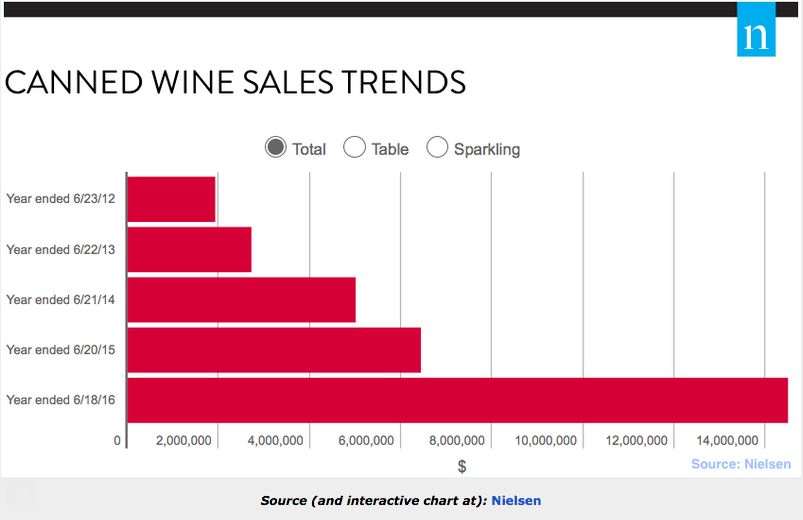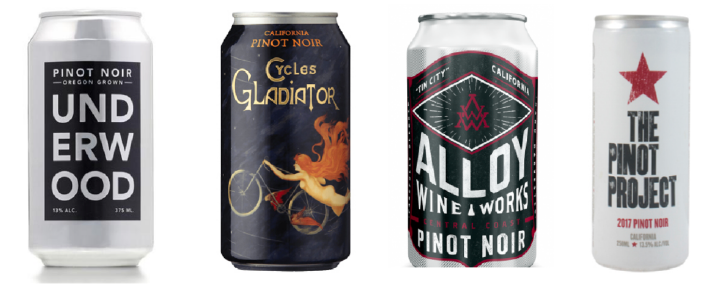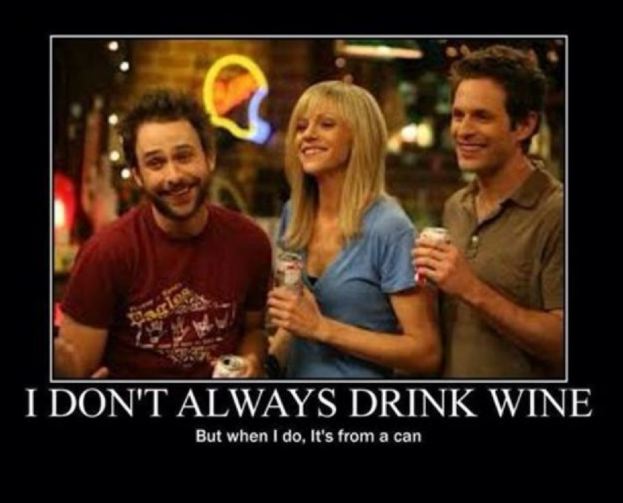Canned Pinot Noir: An Intellectual Pleasure Becomes a Beverage Like Cold Beer
Canned wine sales rose 43 per cent from June 2017 to June 2018 according to the market research firm BW
166. Forbes reported retail wine sales during this period were flat. Nielsen has reported a 125.2 percent
increase in sales of canned wine for the years 2012-1016 (see below)l.
What accounts for the astonishing rise in popularity of canned wine? Why would you want to put Pinot Noir, the
Queen of Wines, in the lowly flip-top beer can? There are a number of reasons. Cans of wine are portable like
canned beer and do not require stems or an opener. They are handy for picnics, concerts, hiking, camping and
the beach, and cans are completely recyclable. Cans are easy to transport, lighter than bottles, unbreakable
and reduce the environmental imprint. The can eliminates the pretentiousness associated with wine drinking
and makes wine more easily accessible.
The canned wines are said to be identical in taste to the same wine packaged in a 750-ml bottle because the
can is lined to avoid unwelcome flavors. Back in 2014, when the Union Wine Company released its Underwood
Pinot Noir in a can, I tasted the Underwood Pinot Noir from a bottle and can and I did not find that they tasted
the same. The bottled version was more aromatic, and had slightly more flavor and verve.
The disadvantages of wine in cans is that the consumer cannot see the color of the wine. They can’t swirl the
wine to release aromas. Once you open the can, you cannot close it. The current wines, particularly the Pinot
Noir, are not premium grade, but more in the under $20 a bottle category. Eventually, there may be more
premium wines available in cans, at $20 and up per can.
Oregon has been at the forefront of canned wine. Union Wine Company was the pioneer, launching a canned
Pinot Noir and Pinot Gris with its Underwood label in 375-ml cans in 2014. In 2018, owner Ryan Harms said
that production was increased by 95% and 55% of the Underwood wines are now put into cans (224,000
cases). The lineup now includes a Rosé, White and Rosé sparkling wines, Riesling, and a fruity wine cooler.
Other Oregon wineries have launched their own line of canned wines including the Stoller Wine Group
(Canned Oregon Sparkling White and Sparkling Rosé), Enso (Portland Sangria), and Dobbes Family Estate
(Joe To Go Pinot Gris, Pinot Noir and Rosé). Read more at http://www.shankennewsdaily.com/index.php/
2018/12/03/21966/oregons-winemakers-spearhead-a-new-wave-of-high-quality-canned-wine-offerings/.
California has entered the fray as well. Francis Coppola Winery recently launched its first canned red wine with
the 2017 Diamond Collection Pinot Noir. Chardonnay, Pinot Grigio and Sauvignon Blanc white wines were
released as part of the same can collection last summer. The 250 ml cans are offered in a 4-pack ($24) that
can be purchased at the winery’s tasting room and online.
7-Eleven sells its Roamer private label brand of canned Chardonnay and Rosé. WineSociety began selling
500 ml cans of wine online in January 2018 and now is sold in Kroger Stores. Right Now canned red, white,
dry Rosé and sweet Rosé debuted in early 2018, offered in 12 ounce cans.
The typical 375 ml or 12 ounce can of wine sells for $6 and is often presented as a four-pack for $24
(equivalent to two standards bottles of wine).
My biggest concern with canned wine is that a typical can contains 375 ml or about 12 ounces, the equivalent
of three standard 4-ounce drinks. Some tallboy wine cans contain almost the equivalent of a 750ml. bottle.
Drinkers are used to polishing off a couple of 12-ounce cans of beer, but drinking two 375 ml cans of wine
would be equal to swigging an entire bottle of wine! Wine is not a utility drink like beer and is meant to be
sipped, not gulped or chugged.





